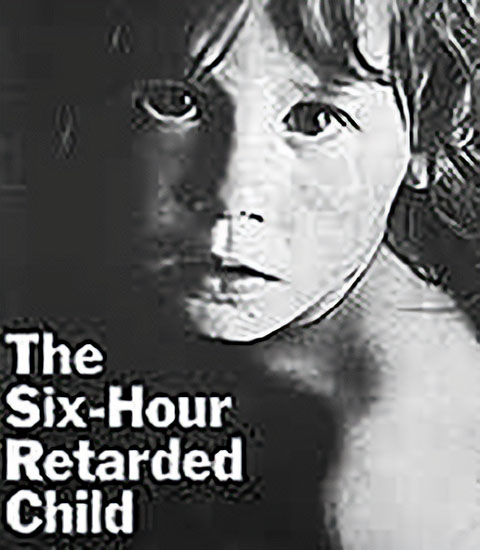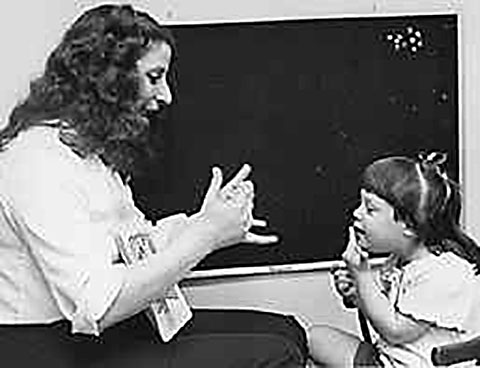Special Education
Education for children with disabilities was one of the first goals of the parents' movement. For years, it was generally believed that children with disabilities should begin schooling at a later age than others because they were slow to learn. But as Gunnar Dybwad stated "Because they needed more time to learn, we gave them less time… Today, one wonders how it was possible for people to be so shortsighted."
In 1953, the ARC issued a position statement, that "every child has the right to a program of education and training suited to his or her particular needs and carried forward in the environment most favorable for each child, whether that be the community public school, the state residential school, or the child's own home.
Prior to 1975, people with severe disabilities seldom received any type of educational instruction. Persons with mild disabilities were categorized as "educable" and had the opportunity to learn basic academic subjects and develop social skills. People with more severe disabilities were categorized as "trainable" and received instruction in self-help skills and socialization.

According to Dr. Gunnar Dybwad, attempts to classify children for the appropriate level of instruction, using the terms "educable" and "trainable," became "more and more damaging, if not pernicious, because [those terms] simply label persons with disabilities for life on the basis of what we earlier judged their adjustment to be to a particular school situation.
In 1966, the President's Panel on Mental Retardation published a booklet entitled The Six Hour Retarded Child. This booklet noted that many students were labeled based on their school work rather than their level of functioning in their family and community.
The use of labels emphasized not only that education must improve for students with disabilities, but also that applying a label to one part of an individual's life results in stigmatizing a person's entire life.
Not only was much of the existing schooling inadequate or misplaced, but significant numbers of children with disabilities were not being educated at all. Thousands of children were simply turned away by schools who said they were unable to educate them and were not required by law to do so.
In 1975, when Congress passed the Education for All Handicapped Children Act, education for all children with disabilities changed dramatically. Regardless of the type or degree of disability, each school-aged child had the right to a "free appropriate public education."

This Act included "transportation, and such developmental, corrective, and other supportive services (including speech pathology and audiology, psychological services, physical and occupational therapy, recreation and medical and counseling services, except that such medical services shall be for diagnostic and evaluation purposes only) as may be required to assist a child [with disabilities] to benefit from special education, and includes the early identification and assessment of disabilities in children.
Children with a wide range of disabilities were now enrolled in public schools. A team of individuals, including parents and students, participated in the development of an Individualized Education Program (IEP) to assure that the unique needs of each student were met.
In January 1971, the parents of several children with disabilities filed a class-action lawsuit, Pennsylvania ARC (PARC) v. Commonwealth of Pennsylvania, claiming that certain state laws unconstitutionally denied a free publicly funded education to children with disabilities and classified certain students as "uneducable and untrainable."
On October 8, 1971, the court entered a Consent Decree that declared several state laws unconstitutional, and required the state to evaluate and place all students with disabilities ages 6-21 in a proper publicly funded educational setting. The court appointed a monitor and retained jurisdiction for enforcement of the Consent Decree.
In 1973, Marian Wright Edelman, founder of the Children's Defense Fund, conducted a survey to determine why 750,000 children appeared in the U.S. Census as not attending school. Edelman suspected that the number represented African-American children kept out of school in segregated settings. In fact, they were children with disabilities. The PARC lawsuit, and Edelman's activism for civil rights and children's rights, provided the basis for Public Law 94-142 (the Education for All Handicapped Children Act) that was enacted by Congress in 1975. Today, the law is known as the Individuals with Disabilities Education Act (IDEA).

As we approach the 50th anniversary of IDEA in 2025, the U.S. Department of Education issued its "45th Annual Report to Congress on the Implementation of the Individuals with Disabilities Education Act, 2023." The Department also published a series of Fast Facts. These key points were presented for children identified with an intellectual disability. https://sites.ed.gov/idea/osep-fast-facts-children-identified-with-intellectual-disability/
- In school year 2021-2022, the percentage of students with an intellectual disability was 6.02% (average across the nation). This was a decline from 8.08% in 2008-2009.
- In school year 2021-2022, students identified with an intellectual disability were more likely to be served inside a regular class less than 40% of the day than all students with disabilities.
- In school year 2021-2022, when compared to all students with disabilities, Black or African American students were more likely to be identified with an intellectual disability, and White students were less likely to be identified with an intellectual disability.
- In school year 2020-2021, students identified with an intellectual disabilities, ages 14-21, who exited schools were more likely to receive a certificate, and less likely to graduate with a regular high school diploma than all students with disabilities.

